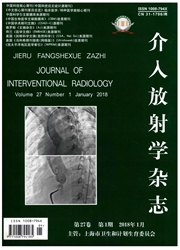

 中文摘要:
中文摘要:
目的 探索经皮射频消融术(RFA)治疗兔椎体肿瘤模型不同消融时间的疗效及安全性。方法采用CT引导经皮穿刺法将VX2瘤块接种入新西兰大白兔的腰椎内,成功建立20只兔椎体肿瘤模型。将其随机分为A、B两组,每组10只。测量肿瘤椎体的核素标准化摄取值(stand uptake value,SUV),然后对实验动物行消融治疗。A组消融持续时间3 min,B组为5 min,观察治疗后24 h动物急性瘫痪发生情况。治疗后第1天和第7天,实验动物再次接受PET-CT检查,测定椎体肿瘤的SUV值,然后取肿瘤标本行病理检查。比较两组动物RFA术后的瘫痪率以及治疗前后不同时间点的肿瘤SUV值有无差异。结果 A、B两组动物射频后的瘫痪发生率差异有统计学意义(1/10比6/10、P〈0.05)。两组肿瘤模型消融前的SUV值分别为4.60±0.47、4.48±0.45,治疗后第1天分别为0.94±0.08、0.92±0.07,治疗后第7天分别为0.93±0.04、0.95±0.06。两组椎体肿瘤的SUV值在治疗前、后差异有统计学意义(F=3 257.87、P〈0.05),两组之间则差异无统计学意义。病理结果显示两组肿瘤模型的肿瘤细胞明显坏死,均未见明显残存肿瘤细胞。结论 应用RFA治疗兔椎体肿瘤,消融时间持续3 min已能有效杀伤椎体肿瘤细胞,且严重并发症的概率小。延长消融时间疗效无显著增加,但可能增加神经损伤的风险。
 英文摘要:
英文摘要:
Objective To explore the efficacy and safety of percutaneous radiofrequency ablation (RFA) by using different ablation time in treating vertebral tumors in experimental rabbit models in order to optimize the ablation time. Methods Vertebral tumor models were successfully established in 20 New Zealand white rabbits by transplanting VX2 carcinoma into the lumbar vertebral body with percutaneous puncture inoculation technique under CT guidance. Twenty vertebral tumor rabbit models were randomly and equally divided into two groups with 10 experimental rabbits in each group. The tumor models in group A and group B were treated by RFA with the ablation time lasting for 3 minutes and 5 minutes respectively. The stand uptake value (SUV) of each vertebral tumor was determined on PET-CT before RFA treatment as well as at one day and 7 days after RFA treatment. Then the rabbits were executed for pathological examinations. The incidences of acute paralysis after RFA were compared between the two groups by Fisher's exact text. The SUV of each vertebral tumor in different group and different time point was analyzed by repeated measures analysis of variance. Results Statistically significant difference in the incidence of acute paralysis after RFA existed between group A and group B (10% vs. 60%, P 〈 0.05). The preoperative SUV of vertebral tumor of group A and group B was 4.60 ± 0.47 and 4.48 ± 0.45 respectively. One day and 7 days after RFA the SUV of vertebral tumor in group A was 0.94±0.08 and 0.92± 0.07 respectively, which was 0.92 ± 0.07 and 0.95 ± 0.06 respectively in group B. In both groups statistically significant difference in SVU existed between the preoperative data and the postoperative ones (F = 3 257.87, P 〈 0.05), although no statistically significant difference in SVU existed between the two groups. Pathologically, typical tumor cell necrosis was demonstrated in both groups, and no obvious residual active tumor cells were seen. Conclusion Employing RFA to treat vertebral tumor in ra
 同期刊论文项目
同期刊论文项目
 同项目期刊论文
同项目期刊论文
 期刊信息
期刊信息
